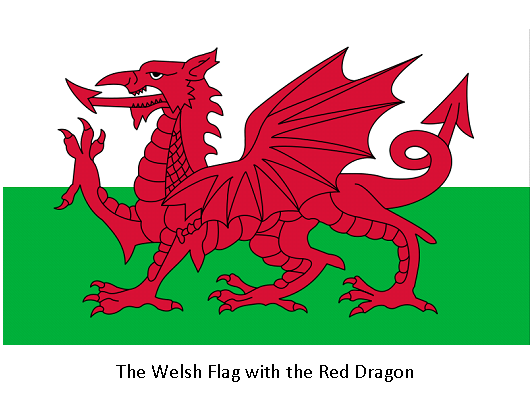Y Ddraig Goch Ddryr Cychwyn
March 1st is Saint David’s Day honoring the patron saint of Wales, the day when Welshmen everywhere remember their Welsh heritage. Wales is part of the United Kingdom and is located on the island of Great Britain. Nonetheless, it is neither English nor Scottish. This land is an ancient country of its own, and has its own language, its own symbols, and its own flags.
While it is true that Wales has a Queen, it is not a kingdom. Wales is part of the United Kingdom, but it does not appear represented on the British Union Flag or on the Royal Coat of Arms. Its status is confusing to many, but yet it is a source of great pride to the Welsh. England, Scotland and Ireland historically are kingdoms, that is to say the realms of kings. On the other hand, Wales was ruled anciently by princes and therefore not a kingdom but a principality. The English conquered the Welsh princes centuries ago, but the Welsh people in their hearts have remained unconquered. They display their national symbols proudly to let the visitor know that they are not in England—but in Wales.
The leek and the daffodil are national emblems of Wales and are worn with pride on Saint David’s day. The daffodil is also known by the Welsh as Cenhinen Bedr or Peter’s leek. According to legend, an ancient Welsh leader, Cadwaladr of Gwynedd, ordered his men for recognition to fix leeks to their helmets during a battle against the Saxons. Today badges of the Welsh guard bear the emblem of a leek. As for the daffodil, it is the national flower of Wales. On Saint David’s day, a daffodil looks better than a leek when worn on a lapel.
Today’s white and green Welsh flag displays Y Ddraig Goch—a Welsh phrase which translates as “The Red Dragon.” Indeed, the dragon is perhaps the oldest symbol of the British Isles. It was carried by the earliest ancestors of the Welsh. The green over white flag has been used by Welsh princes since about 1401, and later the colors were adopted by Henry Tudor, who became England’s King Henry VII to acknowledge his Welsh ancestry. In 1959 Queen Elizabeth II approved this traditional flag for display in Wales and it flies throughout the land.
There is, however, another flag based on the design of the shield carried by the last native Welsh prince, Llewelyn the ‘last’ in about 1240. This design has four quarters of red and gold each displaying a lions of the contrasting color. According to an old tale the Welsh asked England’s Edward I for a Welsh prince to govern them under the king’s authority. While on a military campaign in Wales, King Edward’s son had been born in Caernarfon. The crafty king promised to give the people a prince who was born “on Welsh soil and speaking no other language.” So the king kept his promise to the Welsh by creating his baby son Prince of Wales. Whether or not the story is factual, English Monarchs have since created their eldest sons and heirs as Princes of Wales. Queen Elizabeth’s heir, Prince Charles—as the current Prince of Wales—uses the ancient Welsh shield while adding at its center a green shield with his coronet placed upon it.
Whatever the visual symbol displayed in Wales, the national motto says it all, Y Draig Goch Ddryr Cychwyn which translates as “The Red Drageon gives impetus.”


